Sun 2 Apr 2017
Mike Nevins on ERLE STANLEY GARDNER and “The Case of the Restless Redhead” (Book / TV Show).
Posted by Steve under Columns , Reviews , TV mysteries[12] Comments
by Francis M. Nevins
I can hardly believe it but we are less than six months away from the 60th anniversary of the debut of Perry Mason the TV series. It was a Saturday evening, September 21, 1957, and among the millions of viewers whose sets were tuned to CBS at 7:30 P.M. Eastern time was a bookish 14-year-old, just beginning his second year of high school, who had discovered and gotten hooked on Erle Stanley Gardner’s Mason novels several months earlier.
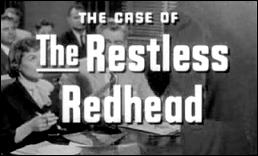
For the next few years I watched the program religiously, catching most of the finest episodes and almost all of those that were at least nominally based on Gardner’s novels. By the time I began dating on Saturday nights the series had become humdrum and routine, at least to my taste, but it remained in prime time for an amazing nine seasons, and countless viewers still identify Gardner’s characters with their TV incarnations: Raymond Burr (Mason), Barbara Hale (his secretary Della Street), William Hopper (private detective Paul Drake), William Talman (DA Hamilton Burger), and Ray Collins (Lt. Tragg).
To mark the occasion, if a bit prematurely, I’m going to devote most of this column to the first episode aired and the book it was taken from.
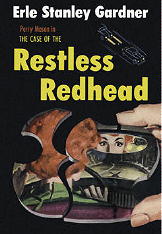
First, the book. The Case of the Restless Redhead (1954) opens with Mason happening upon a trial for larceny in suburban Riverside. Evelyn Bagby, a near-broke waitress with Hollywood dreams, is accused of having stolen $40,000 in jewelry from the trunk of Irene Keith, a wealthy businesswoman on her way to Las Vegas to be bridesmaid at the wedding of movie star Helene Chaney and boat manufacturer Mervyn Aldrich.
Seeing that assigned defense counsel Frank Neely is out of his depth cross-examining the witness who claims to have seen Bagby open the trunk, Mason over lunch offers the young man a few pointers. That afternoon Neely demolishes the prosecution witness and wins a verdict of acquittal. Bagby comes to Los Angeles to thank Mason and they discuss whether she’s entitled to compensation from Keith, who signed the complaint against her.
Bagby suggests that she might have been framed for the jewel theft because she’d recognized a newspaper photo of Chaney’s former husband as the phony drama coach who had swindled her out of her inheritance several years before and whom she had called, demanding restitution. Mason gets her a job as waitress at the Crowncrest Inn, which is on a mountaintop connected with the metro area by a narrow and desolate road.
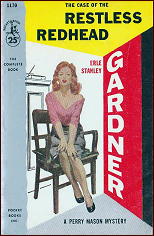
That evening Bagby calls Mason and claims to have found a .38 Colt Cobra with a 2-inch barrel planted in her room at the Inn. Mason tells her to meet him at a certain restaurant, bringing the gun. When they get together she says she was attacked on the mountain road by a man wearing a pillowcase mask, at whom she fired two shots with the .38. Mason reports to the authorities. When he, Della, Bagby and an officer visit the scene of the incident, they find a wrecked car and inside it a dead man, shot in the head and wearing a pillowcase mask.
When it’s discovered that the mask came from the Crowncrest Inn, and that the dead man was in fact the fake drama coach who had cheated her, Bagby like all Mason’s clients gets charged with murder. Much of the rest of the novel takes place at the preliminary hearing where Mason defends her.
Looking at the plot through a microscope reveals flaws here and there. As the hearing begins, the decedent’s body is identified not by the police or a medical examiner but by one of the characters, who isn’t needed as a witness but whom Gardner needs in the courtroom later.
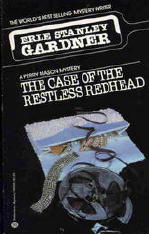
At the end of the book Mason “deduces†a good bit of the plot without a shred of evidence to go on. There are other holes too but they didn’t faze Anthony Boucher and I didn’t let them bother me much either. Boucher in the Times Book Review (7 November 1954) said: “Some intricate defensive maneuvers to confuse the ballistic evidence may baffle not only the judge and the prosecution but also the reader; you’ll have to keep your mind as sharp and devious as Mason’s own to follow this one, but it’s a wonderful roller-coaster ride.â€
For the sake of those who don’t want to have the novel spoiled by my saying too much about the plot, I’ll let the cat out of the bag in a paragraph which will remain hidden unless you click on it. Here, kitty!
The telefilm with which the Mason series debuted keeps the ballistic maneuvers pretty much intact but simplifies the novel in almost every other way imaginable. Irene Keith is dropped, as are fledgling lawyer Frank Neely and his fiancée and the whole larceny trial with which the book opens. The rationale for the titular adjective, that Bagby likes to keep moving from one place to another, winds up on the cutting-room floor, leaving us with nothing but alliteration for its own sake.
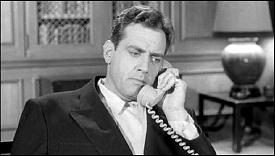
Bagby’s bullets, which in the novel complicate the plot by striking certain objects, on the small screen hit nothing. The ballistic testimony which dominates several chapters of the novel is cut to the bone. But with something like 52 minutes of air time to do justice to a full-length book, what option other than cutting was available?
All in all, adapter Russell S. Hughes did a creditable job. It was the only teleplay he wrote for the series. Before the first season’s end, he had died. Age 48. Cause unknown.
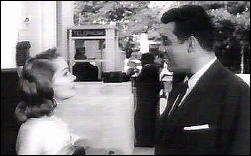
Raymond Burr as Mason is spectacularly slender, having reportedly lost between 60 and 100 pounds while preparing for the part, and smokes up a storm, as do several other characters including his client, who is seen finding the planted .38 in her cigarette box. The client was played by lovely Whitney Blake (1926-2002), who will also pop up later in this column.
Prominent in the cast were Ralph Clanton (Mervyn Aldrich), Gloria Henry (Helene Chaney) and Vaughn Taylor (Louis Boles). The first several minutes could be mistaken in dim light for film noir, thanks especially to ominous background music by the never-credited Ren Garriguenc (1908-1998), whose talent (when he wanted to exercise it) for sounding like his CBS colleague Bernard Herrmann has fooled experts. Bits and pieces of Herrmann music are heard here and there but they are few and far between.
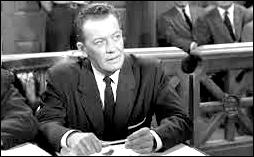
About the director, William D. Russell (1908-1968), not a great deal is known. He began making movies after World War II at Paramount, where he helmed several “heartwarming†comedies. During a pit stop at RKO he made Best of the Badmen (1951), a Western starring Robert Ryan, Claire Trevor, Robert Preston and Walter Brennan, which can be seen complete on YouTube.
Like so many directors of his generation who saw their careers crumbling thanks to TV, he embraced the new medium and began specializing in situation comedies, directing 61 episodes of Father Knows Best before moving to CBS. There he took up more serious fare, notably a few early episodes of Gunsmoke and 28 of Perry Mason.
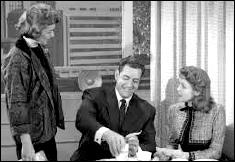
Afterwards he went back to the sitcom, directing 48 segments of Dennis the Menace and 128 of the 154 episodes of Hazel (1961-66), starring Shirley Booth as live-in housekeeper for an affluent family, the female head of which was played by — I told you she’d pop up again! — Whitney Blake. (Whether she arranged for Russell to come aboard, or vice versa, or whether it’s just a coincidence, remains what Russell concentrated on for a few years and then dropped: a mystery.) Less than two years after the series was cancelled — which happened the same year Mason was cancelled— Russell died. Age 59. Cause unknown.
On top of all his novels and stories and travel books and Court of Last Resort pro bono work on behalf of the wrongfully convicted, Erle Stanley Gardner kept up a gargantuan correspondence. One of his correspondents was Harry Stephen Keeler (1890-1967), the wackiest wackadoodle who ever sat down to a typewriter. Several of Harry’s multi-colored “Walter Keyhole†newsletters, assembled and arranged by me in The Keeler Keyhold Collection (2005), include quotations from ESG’s letters to him.
In one of them, probably dating from the late Fifties or early Sixties, Gardner alluded to the fact that both his mother and Keeler’s happened to have the same first name; an odd one to say the least. “Now ‘Adelma’ [Keeler wrote] is not a recognized name….Name experts say that it is undoubtedly an artificial synthesis, or fusion, of the names ‘Adeline’ and ‘Thelma’.â€
Why not Adelaide, or Selma? After comparing notes, the two discovered “that a grandfather of each had been in the Civil War†(presumably on the same side) and concluded that “over some camp fire their grandfathers must have met, and talking of possible ‘odd’ names for girl-children, agreed…to name their first daughters ‘Adelma’.†Well, maybe. Anyway it’s a good story.
April 2nd, 2017 at 1:46 am
The 60th anniversary of the premiere of the Perry Mason series …
According to a great book I acquired a year or so ago (The Case Of The Alliterative Attorney, by Bill Sullivan and Ed Robertson), “Restless Redhead” was actually the fifth episode that was filmed for the first season in 1957.
The actual pilot, “TCOT Moth-Eaten Mink”, was filmed more than a year before, in October of 1956; it aired as the 13th episode in December of ’57.
This was back in the days when all TV episodes were ‘stand-alones’; they could be run in any order.
I’ve often wondered how network brass determined the order in which episodes were shown.
In “Moth-Eaten Mink”, for instance, Raymond Burr’s hair is noticeably shorter than in other episodes – it’s almost a crew cut.
In other ways, “Moth-Eaten Mink” is an atypical Mason show: among other things, the big reveal doesn’t happen in the courtroom, as was part of the ritual.
In Alliterative Attorney, the authors reveal that CBS boss William Paley didn’t like “Moth-Eaten Mink”, and ordered that another, more typical Mason be used as the premiere – hence, “Restless Redhead”.
If I read the book correctly, about a third of the season’s schedule (39 episodes total) was in the can when Mason premiered in September.
I wonder what would have happened if the “Moth-Eaten Mink” pilot had aired first – would Perry Mason have fared any differently with critics and audiences, in terms of reaction?
Something to think about …
April 2nd, 2017 at 10:33 am
There are also series that are meant by their creators to be shown in a certain order, but the suits in charge decide otherwise. Then they wonder why their shows fail when viewers give up and stop watching.
I think but am not sure that the early days of the Fox network were like that.
April 2nd, 2017 at 11:43 am
It goes back further than Fox.
The classic story:
CBS honcho Jim Aubrey hated the Gilligan’s Island pilot so much that he demanded its re-editing; the premiere episode was in fact parts of three episodes smooshed together, including roughly half the pilot.
Gilligan’s creator Sherwood Schwartz (“Robin Hood’s Rabbi”) maintained his whole life that the rotten critical reception was due at least in part to the jerry-built debut show.
Back to Perry Mason for a bit:
After I stood down last night, I went back to Alliterative Attorney, which includes among its multitudinous data the dates of the filming of the individual episodes.
As a rule, Mason kept pretty close to a deadline as far as production to air date was concerned. Often, though, I noticed that certain episodes that were filmed early in a season were held for airing until later – often, much later.
This was true throughout Mason‘s nine-year run.
Devotees will recall that during season 9, Raymond Burr changed his hairstyle from the trademark pompadour to a kind of cap-cut, which he retained in the early days of Ironside a year later.
The change happened several shows into the season; I recall that some viewers wrote to the TV columns that Burr’s hair seemed to be back-and-forth from one week to the next, and wondered “WTF” (or its 1966 equivalent).
What they seemed most thrown by was the fact that the shorter haircut called attention to Burr’s increasing girth.
During this same period, nobody seemed to notice that William Talman was becoming noticeably thinner, from the onset of his cancer (which the public didn’t know about at that point).
Now that I think about it, when Ray Collins fell ill, CBS would space out his decreasing appearances over the course of his last seasons.
A similar strategy was employed when Talman’s suspension ended early in the run; CBS scheduled his “comeback” shows so he didn’t just reappear all at once.
This was possible in the days when series did 30+ episodes a season, in more-or-less constant production in-season; today, in the era of ‘arcs’, not done any more.
But that, as Mr.Kipling keeps saying, is another story …
April 2nd, 2017 at 1:45 pm
Reading “The Case of the Restless Redhead” around 15 years ago, my notes say I liked the opening chapters with Perry Mason helping lawyer Frank Neely. But felt the book declined after that. I can’t remember any of the novel’s details though.
This glowing positive review is making me think that the novel should be re-read.
I’ve seen very few shows directed by William D. Russell.
“The Photographer” on Gunsmoke is about a decadent cameraman (Sebastian Cabot) with creepy ideas about picture taking. Can a Western be decadent? This show tries.
“One Angry Grindl” is about Grindl (Imogene Coca) serving on a jury. I enjoyed this episode as a kid; have always wanted to see it again. The title plays on “Twelve Angry Men”.
April 2nd, 2017 at 4:24 pm
The most famous example of a network (Fox) killing a series by airing episodes out of order is Firefly.
I am a fan of the Mason books (though it has been years since I read one) and the TV series. I no longer enjoy the stand-alone episode style. Such format is locked in too much formula for me to find it dramatically interesting. For example a MASON episode breaks down to first part guest cast establishes suspects and crime. Mason enters (sometime early and sometime as later as second act). The villain will confess at ten minutes before the hour and after commercial we return for the tag – a few minutes filling up plot hole and establishing regular characters. Every story begins at point A goes to B but always ends back at the beginning point A with no growth in the characters or premise.
I tend to be bored by the guest suspects and don’t enjoy the drama until Mason appears. It is a rare episode where the tag at the end is not my favorite part of any episode.
I like the serial form because anything can happen. The dramatic developments of this week episode matters to the premise and characters. My favorite series currently is THE EXPANSE based on a series of books. It surprises me, its story is the focus (it is also supported by incredible special effects and a great cast). No episode is wasted, every moment is important.
Streaming helps you catch up for serial series (Season One is on Amazon prime and current series I believe is on syfy website). THE EXPANSE is telling a story like a book reads, but some of the serial series such as iZOMBIE has a different theme each year so its like reading a book a season.
MASON has been told in serial form – on radio. While I like TV’s PERRY MASON, I wish they could have broken the stand-alone formula and opened up the characters beyond the last five minutes.
April 2nd, 2017 at 6:27 pm
FIREFLY was the first example that came to my mind, Michael. It’s probably the most famous example of a show surviving a decision to play the series out of order. Others this happened to died quickly, and nobody remembers them.
As for continuing story lines, there were none in the Perry Mason novels, so I’m sure it never occurred to the producers of the TV show to do anything as radically different, such as giving the characters a home life or romantic relationships.
I’m not a big fan of TV series with continuing story lines myself. I’m only an occasional viewer, and if I happen to have a episode of the new HAWAII FIVE 0 on, just as an example, and it has a more than incidental story line about their continuing hunt for a character who’s gone missing for the past five weeks, I say whatthehell, give up and turn it off. I like NCIS for their mostly one and done episodes. I find the story arcs that begin with two or three episodes at the end of one season and continue into the next totally boring.
If, however, I have the series on DVD and I can watch a multi-episode story over all or part of a season, at my leisure, no problem.
April 2nd, 2017 at 8:56 pm
The lack of characterization in PERRY MASON TV series was demanded by Erle Stanley Gardner who hated the films or radio giving Perry and Della a romantic relationship. The traditional mystery is often criticized for its lack of deep characters. Yet there is great comfort in the sameness of the form.
I used to watch the old CSI but I could forecast what would happen and when. “They need this to happen in the third break but it is a false clue as they will have a final twist in final act.” That got boring quick so all I have left to watch are characters I find interesting – a reason we watch the mystery MASON despite having seen the episodes dozens of times.
We watch TV differently. That is why the same day ratings are near meaningless as networks and advertisers use different numbers such as L+7 (number of viewers in live and the seven days after). Next year will get even more weirder as Nielsen develops a way to count those watching in places besides home and in different times than the scheduled one. The stand-alone TV episode fits live TV but the serial one works for those of us who watch streaming or downloaded season pass or DVDs.
April 3rd, 2017 at 9:05 pm
Reading this it occurred to me to wonder if enough time has passed another actor could play PERRY MASON successfully.
Granted there are many other problems with reviving the series, and little or no demand, but was Burr so indelible that even today he couldn’t be replaced?
April 3rd, 2017 at 10:14 pm
A good question. They tried with IRONSIDE and failed, and so did the second PERRY MASON, but maybe enough time has passed … ??
The problem though is as you say, little or no demand.
April 4th, 2017 at 12:17 am
Most of the success of any TV series is luck and being in the right time slot at the right time. Certain Gardner’s Mason would not survive in this era romance so heavily included in all fiction. There would have to be a romantic relationship or past affair between Perry and Della. The low violent mystery stories would change. The use of guest suspects as the focus of the first act would be gone as the star or regular cast would always come first today (it has been a long time since I saw any scene – except for the crime – that did not contain at least one member of the regular cast).
April 4th, 2017 at 7:38 am
All good points, Michael. I just don’t see the old formula PERRY MASON coming back, and the formula is so carved in stone I can’t see changing it would satisfy anyone. It just wouldn’t be Perry Mason.
Unless … if done on the scale of a smaller cable channel, such as NERO WOLFE on A&E, it might be able to stick to the old format and have enough of a niche audience to be successful.
Here’s another question. What was the reason that the revival of the IRONSIDE series failed so badly? I watched the first one and thought it OK, or even better, but it was cancelled before I got around before watching another.
April 4th, 2017 at 7:22 pm
Didn’t we have this question back when it happened?
First off, that was no “revival” of Ironside.
They – the eternal, amorphous “they” – stuck a “presold” title on a completely different series, with different characters, a different background, and a completely different style.
Give the show a different title, and don’t try to pretend any relationship to the earlier show, and maybe you’ve got a shot.
Just happened to think of this:
Within my memory, going back 50 years (50 freakin’ years!) I can recall at least three different series that all bore the same title: That’s Life!
The first one, from 1968, was a weekly musical comedy starring Robert Morse.
The second one, from the late ’90s, was a very short-lived sitcom, mainly recalled (if at all) because its star, a standup comic named Gerry Red Wilson, died almost immediately following its cancellation.
The third one, from the turn of 2000 or thereabouts, was a dramedy about an Italian-American family headed by Paul Sorvino and Ellen Burstyn; this was the only one that made it into a second season – but not long after that.
I’m betting that most of you all don’t remember any of these three shows (people my age might recall the Morse musical show).
Had any of them had a less generic title – who knows?
My point here – I’m not sure I have one, exactly …
… but think about it a bit – maybe you can …